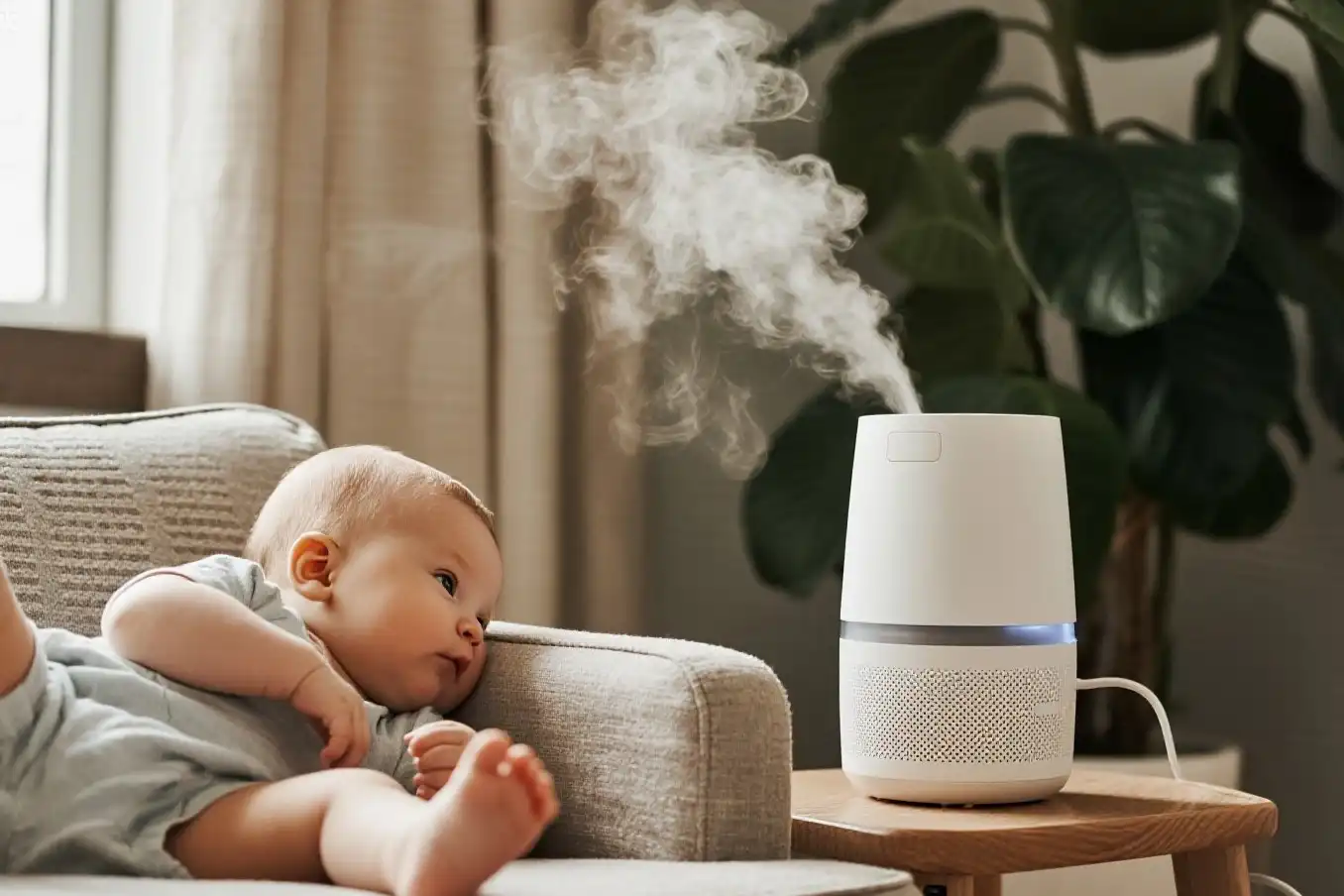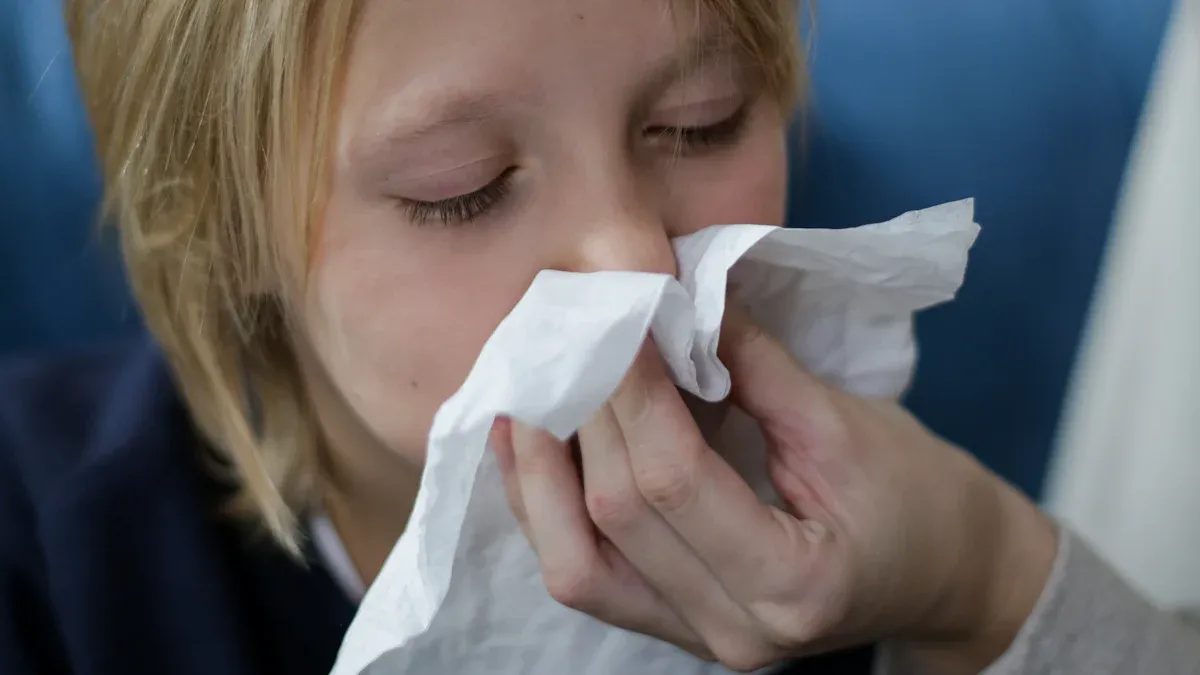
When your baby has sinus problems, experts often recommend using a humidifier rather than an air purifier and humidifier combo. It’s best to choose a cool-mist humidifier when your baby has a cold or when the air in your home feels dry. The humidifier helps thin mucus and keeps your baby’s nose moist. Always use distilled or boiled water in the humidifier and clean it every few days. Maintain the humidity level between 30% and 50%. While both an air purifier and humidifier can be helpful, a humidifier alone works better for babies with stuffy noses.
Key Takeaways
- Use a cool-mist humidifier to help babies breathe easier. It helps with stuffy noses and dry air. It keeps their nose moist and makes mucus thin.
- Pick a HEPA air purifier to get rid of allergens and pollutants. This helps babies with allergies or asthma breathe better.
- Keep humidity between 30% and 50%. This protects sinuses and stops mold or dust mites from growing.
- Clean both devices often to stop mold and bacteria. This keeps your baby safe from harm.
- Use both an air purifier and humidifier together if your baby needs clean and moist air. Always follow safety rules when using them.
How They Work
Air Purifier Function
An air purifier helps clean the air in your house. It pulls air inside and uses filters to catch dust, pollen, and pet dander. Most air purifiers have HEPA filters that trap tiny allergens and pollutants. Some also use activated carbon filters to get rid of bad smells and chemicals. A few advanced models use UV light or other methods to break down harmful gases and germs.
Scientists say air purifiers work in two main ways. First, they take out particles from the air with filters. Second, they can break down some gases and germs using special technology. For example, studies show air purifiers can lower airborne viral particles by more than 90% in closed rooms. Doctors suggest air purifiers for people with allergies or asthma because they remove allergens from the air. You might sneeze less and sleep better if you use a good air purifier.
Tip: Change your air purifier’s filter often and keep it clean. This helps the machine work well and keeps your air fresh.
Humidifier Function
A humidifier puts more moisture into the air. You add water to the device, and it sends out a cool or warm mist. This extra moisture keeps your nose, throat, and skin from getting dry. If your home’s air is dry, you might feel stuffy or get a sore throat. Using a humidifier can help you breathe easier, especially in winter or when the heater is on.
Doctors say humidifiers help by keeping your airways moist and thinning mucus. This makes breathing easier and can help stop coughing and stuffy noses. Studies show people who use humidifiers cough less and feel better during dry times. Raising the humidity in your house can also lower the number of viruses in the air. Research found that raising humidity from 29% to 54% cut virus particles in half.
- Humidifiers calm irritated airways.
- They help your body fight sickness by keeping mucus moist.
- The right humidity makes your home feel nicer.
Air Purifier and Humidifier: Benefits for Infants
Air Purifier Pros and Cons
Air purifiers help keep your baby’s room air clean. They take out dust, pollen, pet dander, and germs. HEPA filters catch almost all tiny particles. This helps protect your baby’s lungs. Activated carbon filters remove bad smells and gases. This makes the air safer for your baby. Babies breathe more air than adults for their size. Clean air is very important for their health.
Note: The American Academy of Pediatrics says HEPA air purifiers can cut indoor pollution by half. This helps lower asthma problems and keeps your baby safe from bad particles.
There are some risks to know. Ozone-producing air purifiers can hurt your baby’s lungs. Always pick a purifier with a HEPA filter. Check for certifications like CARB or UL 2998. These show the purifier does not make much ozone. Some air purifiers are loud and can wake your baby. Choose quiet ones and put them three feet from the crib. Keep cords away from your baby. Change filters on time to stop mold from growing.
Pros of Air Purifiers for Infants:
- Take allergens and pollutants out of the air.
- Lower the chance of infections and allergies.
- Help babies with asthma or sensitive lungs.
- Help babies sleep better by stopping sneezing and coughing.
Cons of Air Purifiers for Infants:
- Ozone-producing types can cause breathing trouble.
- Loud machines might wake your baby up.
- Not cleaning them can cause mold or bacteria.
- Some have small parts or bright lights that are not safe.
| Feature | Benefit for Infants | Risk/Consideration |
|---|---|---|
| HEPA Filter | Takes out allergens | Needs filter changes often |
| Activated Carbon | Removes smells and gases | Not every model has this |
| Ozone-Free Design | Safe for baby’s lungs | Must check for certification |
| Quiet Operation | Helps babies sleep better | Some are still noisy |
Humidifier Pros and Cons
A humidifier adds water to the air. This helps when your baby has a stuffy nose or dry skin. Dry air can make coughing and stuffiness worse. A humidifier can help your baby feel better. Doctors say cool mist humidifiers are best for babies. They do not get hot, so they are safer. Moist air keeps your baby’s nose and throat wet. This makes it easier to breathe and sleep.
Tip: Put the humidifier three feet from the crib. Use distilled water to stop mineral dust.
Humidifiers can have problems too. If you do not clean the tank, mold and bacteria can grow. These can get into the air and make your baby sick. Too much humidity can cause dust mites and mold in the room. This can make allergies or asthma worse. Keep humidity between 30% and 50%. Use a hygrometer to check the level. Never put oils or chemicals in the humidifier. These can hurt your baby’s lungs.
Pros of Humidifiers for Infants:
- Help with stuffy noses and dry skin.
- Stop dry skin and eczema.
- Support your baby’s natural airway defenses.
- Help babies sleep better by making the air comfy.
Cons of Humidifiers for Infants:
- Can spread mold or bacteria if not cleaned.
- Too much humidity can cause dust mites and mold.
- White dust from tap water can bother airways.
- Electric dangers if too close to the crib or if water spills.
| Feature | Benefit for Infants | Risk/Consideration |
|---|---|---|
| Cool Mist | Safe, no burn danger | Needs cleaning often |
| Proper Humidity Level | Helps breathing, stops dryness | Too much humidity is a risk |
| Distilled Water | Stops mineral dust | Tap water can make white dust |
| Automatic Shut-Off | Stops running dry | Not every model has this |
When Each Device Helps Most
You might wonder when to use an air purifier or humidifier. If your baby has allergies or asthma, use an air purifier. It takes out bad particles and keeps air clean. If your baby has a stuffy nose or dry skin, use a humidifier. It adds moisture and helps your baby breathe easier.
Callout: Do not use these devices instead of seeing a doctor. If your baby does not get better, talk to your pediatrician.
You can use both devices if your baby needs clean and moist air. Always follow safety tips and keep both machines clean and working well.
Sinus Problems: Which Helps More?

Air Purifier for Sinus Relief
Your sinuses can get irritated by dust, pollen, or pet dander in the air. An air purifier takes these small things out of the air. HEPA filters in air purifiers catch almost all tiny particles. This means you breathe in fewer things that bother your sinuses. Activated carbon filters also take away smells and gases that can make your nose feel worse.
Air purifiers help most if you have allergies or live where there is a lot of dust or pollution. You can use them in your bedroom, living room, or any place you spend time. Some air purifiers have extra features like UV-C light to kill germs, but the main help comes from the filters.
Tip: Pick an air purifier with both HEPA and activated carbon filters for the best results. Make sure it fits your room size and change the filters often.
Here is how air purifiers help your sinuses: They catch dust, pollen, pet dander, and mold spores that can bother your sinuses. They take away chemical smells and gases that make sinus problems worse. They lower the chance of getting long-lasting sinus problems by cleaning the air. They help you breathe better if you have allergies or asthma.
| Feature | What It Does for Sinus Relief |
|---|---|
| HEPA Filter | Takes out tiny particles and allergens |
| Activated Carbon Filter | Removes gases and bad smells |
| Multiple Filtration Technologies | Gives more protection from dirty air |
| Proper Sizing and Placement | Makes sure air gets cleaned well |
| Regular Maintenance | Keeps air clean and the device working |
Air purifiers do not put water into the air. If dry air is why your sinuses hurt, an air purifier alone may not help much. But if you react to things floating in the air, this device can really help.
Humidifier for Sinus Relief
Humidifiers add water to the air, which helps your nose and sinuses feel better. Dry air can make your nose crack, swell, and fill with thick mucus. Using a humidifier helps thin the mucus so you can breathe easier. Wet air also calms your nose and throat and helps with dry eyes, which can come with sinus problems.
Doctors say to keep the humidity in your house between 30% and 50%. This level helps your sinuses and stops mold and dust mites from growing. If humidity is less than 30%, your nose can dry out and get infected more easily. If it is more than 50%, you might get more mold and dust mites, which can make sinus problems worse.
Note: Always use distilled water in your humidifier and clean it often. This stops germs and mold from getting into the air.
Humidifiers help your sinuses by adding water to dry air so your nose does not dry out. They help thin mucus so you can clear your nose. They calm your nose and throat and help stop coughing. They lower the chance of sinus infections by helping your body fight germs. They can also help stop some viruses from spreading by keeping the air moist.
You can see humidifiers help in these ways: People with sinus infections often feel less stuffy when they use a humidifier. Studies show humidifiers can lower the number of viruses in the air and on things. Kids and adults both say they have less dry nose and throat when using a humidifier.
| Humidity Level | What Happens to Sinuses |
|---|---|
| Below 30% | Nose dries out, cracks, and swells |
| 30%-50% | Sinuses stay wet and feel good |
| Above 50% | Mold and dust mites can grow more |
Using both an air purifier and humidifier together can help the most, especially if you have allergies and dry air at home. Each device helps with a different problem. The air purifier takes out particles, and the humidifier keeps your nose wet.
Choosing and Using Safely
When to Use Each Device
You need to pick the best device for your child. Think about what your child needs most. Here are some things to help you decide:
- If your child has allergies or asthma, use a True HEPA air purifier. This device takes out allergens and helps your child breathe better.
- If your child has dry skin or a stuffy nose, use a humidifier. Pick one that controls humidity by itself. Try to keep the moisture between 40% and 60%.
- If your home has dry air and allergens, use both devices together. Choose an air purifier with a carbon filter. Get a humidifier with UV sterilization for the best results.
- Always ask your pediatrician if your child keeps having symptoms.
| Factor/Aspect | Humidifier | Air Purifier |
|---|---|---|
| Main Use | Adds moisture to air | Removes allergens and pollutants |
| Best For | Dry air, dry skin, congestion | Allergies, asthma, polluted air |
| Safety Features | Auto shutoff, quiet mode | Ozone-free, quiet, filter indicator |
Using Both Together
You can use both an air purifier and humidifier in one room. Put them on different sides of the room. This stops the mist from blocking the purifier’s filter. Keep both away from walls and furniture. This helps air move well. Use a hygrometer to check the humidity. Try to keep it between 30% and 50%. Clean both machines often to stop mold and bacteria.
Tip: Start your humidifier on low or medium. Change the setting if the humidity goes up or down.
Safety and Maintenance
To keep your child safe, always use cool-mist humidifiers. Use distilled water and clean the tank every day. Disinfect all parts once a week with vinegar or hydrogen peroxide. Let everything dry before putting it back together. For air purifiers, change filters every 3 to 6 months. Keep both machines out of your child’s reach. Never add oils or scents. Watch for mold or bad smells and clean right away.
Note: Always follow the manufacturer’s instructions for cleaning and filter changes.
When you pick between an air purifier and humidifier, think about what your child needs most. If your baby has allergies and dry air, use both devices together for better results. Air purifiers take out dust and allergens all year. Humidifiers help most when the air is dry. Always clean the machines and check the humidity level. If your child’s sinus problems do not get better, talk to your doctor for more help.
FAQ
What is the safest humidifier for a baby’s room?
Pick a cool-mist humidifier for your baby’s room. This kind does not get hot, so it cannot burn your baby. Always use distilled water in the humidifier. Clean it often to keep the air safe.
What does an air purifier remove from the air?
An air purifier takes out dust, pollen, and pet dander. It also removes some germs from the air. HEPA filters catch very small particles. Activated carbon filters take away bad smells and gases. This gives your family cleaner air to breathe.
What humidity level helps with sinus problems?
Keep the humidity between 30% and 50% in your home. This range helps your nose and throat stay moist. It also lowers the chance of mold and dust mites growing.
What should you avoid putting in a humidifier?
Do not put essential oils, perfumes, or chemicals in the humidifier. These things can hurt your baby’s lungs and make breathing hard. Only use clean, distilled water every time.
What is the best way to clean these devices?
Clean your humidifier every day and disinfect it once a week. Change the air purifier filter every 3 to 6 months. Always follow the instructions from the maker to keep your air safe.
See also
The benefits of air purifiers for illness prevention and health improvement
Air Sanitizer or Air Purifier What’s the Right Choice for You in 2025
